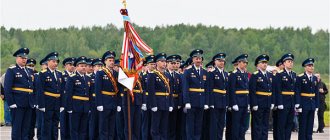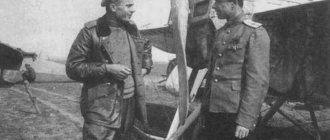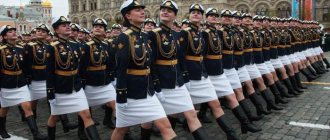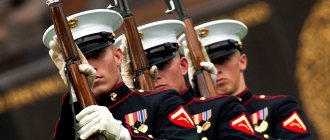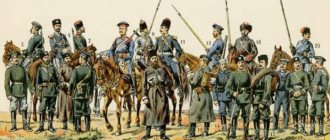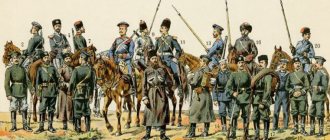Since the founding of this type of troops, the uniform of the Airborne Forces was no different from the clothing of the Red Army Air Force or special purpose air battalions. The set of clothes for a USSR intelligence soldier included:
Leather or blue-gray canvas helmet. Moleskin overalls (could be either leather or blue-gray canvas). The collar of the overalls was equipped with blue buttonholes, where insignia were sewn.
Already in the forties, the military uniform for aerial reconnaissance was changed to avisent jackets with trousers. The pants had huge patch pockets. The winter clothes of the USSR paratroopers were insulated with sheepskin uniforms: a brown or dark blue fur collar, which was fastened with a zipper.
The first military uniforms in the USSR
At the beginning of the war, overalls were replaced by avisent jackets and trousers with large patch pockets. Under their jackets and trousers, Airborne Forces personnel wore standard combined arms uniforms. Winter uniforms were insulated with a large dark blue or brown sheepskin fur collar, which was fastened with a zipper and covered with a counter flap. The winter clothing of soldiers during the Finnish war also included a hat with earflaps, a padded jacket, padded trousers, a sheepskin coat, felt boots, and a white camouflage robe with a hood. The buttonholes were blue for all categories of military personnel. The only difference was the edging, which was golden for commanders and black for petty officers, sergeants, privates and political workers.
Blue piping along the collar, along the side seams of the riding breeches and along the cuffs at the end of the sleeves was a distinctive feature of the commander's uniform. The commander's uniform was complemented by a dark blue (since 1938) or protective green (since 1941) cap with a blue edging on the crown and band, and the rim of the cap. After 1939, a cockade appeared on the cap, consisting of a red star superimposed on a double gilded bay surrounded by a laurel wreath. The Airborne Forces cockade is still decorated with a similar star. Another common headdress is a dark blue cap with blue piping and a cloth star, on top of which a red enamel star was attached.
Before a parachute jump, commanders put on caps equipped with a strap that was worn over the chin. The Red Army soldiers simply hid their caps in their bosoms.
Summer option
The ceremonial version of the uniform of military personnel of the Russian Aerospace Forces, for cadets and enlisted personnel, of the summer type is a suit. It can be blue or khaki. Under his tunic, a private is required to wear a shirt of the same color, complemented by a tie with a gold tack. Officers are expected to wear a jacket and trousers of the same colors in combination with a white shirt and black tie. The cap of a VKS serviceman must be matched to the color of the suit. The set should include a gold belt.
The field version of the uniform for privates and cadets of the VKS, abbreviated as VKPO, is no different from the uniform version for the ground forces. The kit should include the following clothing items:
- short sleeve underwear;
- jacket with trousers;
- summer boots;
- cap;
- nude summer T-shirt.
Find out: What military ranks were there in the USSR army, what shoulder straps did the soldiers wear?
The office uniform for military personnel of the Russian Aerospace Forces differs in color from the uniform of other branches of the military. For military personnel of the military space forces it is blue. Otherwise, in style and details, it is similar to the uniform of other troops. Stripes and shoulder straps are issued in accordance with the serviceman's type of troops and his ranks.
Airborne Forces lapel emblem
The modern military uniform of the Airborne Forces is almost unthinkable without the famous sign - a parachute with two aircraft on both sides. It does not just mean that a serviceman belongs to aviation, it is a real symbol of the unity of paratroopers. The Airborne Forces uniform has been decorated with this lapel insignia since 1955, when the Soviet Army was transitioning to a new uniform and it was decided to develop new insignia for different types and branches of the military. Commander-in-Chief V.F. Margelov A real competition was announced, as a result of which the winning drawing was created by a draftswoman serving in the Soviet Army. This simple, but soulfully created emblem formed the basis for the creation of various airborne symbols and became the main component of award badges and sleeve patches.
Main headdress
In the Soviet Army, the beret first appeared as a headdress only in 1941. And then it was part of the women's summer military uniform. The Airborne Forces uniform was replenished with a beret only in 1967. During this period, it was crimson in color, in unison with the attribute of the airborne troops of other countries. The distinctive sign was a blue flag called a corner. The size of the corner was not regulated. Berets were worn by both officers and soldiers. However, the officers had the Airborne Forces cockade sewn on their front, while the soldier’s beret had a red star with ears of corn. But a year later, the color of the beret became the usual blue, which it remains to this day, and the star with ears of corn was replaced by a star in an oval wreath. The corner of the beret became red, but there was no strictly regulated size until 1989.
The modern appearance of the beret of the Russian Airborne Forces has remained virtually unchanged since Soviet times. In front there is also a red star, surrounded by ears of corn. The corner, which now looks like a Russian tricolor, with a St. George ribbon and a golden parachute trailing behind it, is sewn on the left side of the beret.
Field
This type of military uniform is required:
- for educational events;
- during hostilities;
- during training;
- in combat;
- when a state of emergency is declared;
- to eliminate the consequences of disasters, accidents and other disasters.
The Minister of Defense of the Russian Federation, Army General Sergei Shoigu, approved a new model of the field uniform, pointing out a number of improvements, since the previous uniform did not meet the requirements in many respects. Examples of this can be found in numerous pictures presented on the Internet. At the moment, testing of clothing is taking place in the troops themselves.
The main feature of the latest field uniform for military personnel is that it is multi-layered. Previously, only field equipment for special forces units was manufactured using this principle.
The VKBO includes 23 items of clothing, which also include three pairs of shoes. The combination of eight layers of clothing allows military personnel to use this field uniform in the off-season and winter, that is, when the temperature ranges from + 15 to – 40 degrees Celsius.
The field uniform includes eight layers of clothing, which include the following items:
- Lightweight underwear;
- Fleece underwear;
- Fleece jacket;
- Windbreaker;
- Demi-season suit;
- Windproof suit;
- Insulated vest;
- Insulated suit.
Thus, the combination of different layers is selected depending on the weather and the intensity of physical activity experienced by officers and soldiers. But if the air temperature is more than fifteen degrees, then a summer field uniform is required.
LightweightFleeceFleece jacketWindbreakerDemi-seasonWindwaterproofVestInsulated
Summer
The new sample summer field uniform includes the following items of clothing:
- lightweight jacket;
- light boots;
- beret or cap;
- trousers.
In the manufacture of this uniform, stretch is used, which is first treated with a water-repellent compound. When it comes to parts with the greatest load, the application of reinforcing components is required, which protects the suit from mechanical damage and the degree of wear becomes minimal.
When service takes place in cooler conditions, it is required to wear a component of a military uniform, namely a fleece jacket, which has thick pile on both sides of the product. The jacket has a durable layer of thermal insulation, but, if necessary, it can be easily rolled up and will take up minimal volume. In windy weather, use a windbreaker jacket, which is worn together with trousers.
JacketBootsBeretCapPants
Winter
In cool weather, you will need to wear a military uniform such as a demi-season set, which reliably protects from the wind. The fabric of the suit allows steam to pass through perfectly, but at the same time it dries quickly. In special situations, waterproof clothing is required, even the seams are taped with a special glue.
During severe frosts, a more insulated suit and vest are required, which are quite light but practical. The winter field uniform is made from waterproof materials that also protect from the wind. In cold weather, you are allowed to use a balaclava, which is worn as a hat or together with it.
JacketPantsHatBalaclava
New sample of the Airborne Forces uniform
Various conditions and situations in which a paratrooper, or any other military personnel, may find themselves dictate certain requirements directly to the uniform, fabrics and colors used. And, of course, we should not forget about functionality. The new airborne uniform was made from high-quality material from Russian manufacturers using the latest nanotechnology. In particular, it is a ripstop fabric with a reinforcing weave structure and reinforced thread, which increases the strength of the material without increasing its weight.
Much attention was paid to the development of the winter kit, which was tested in very low temperatures and strong winds. Men's coats for officers are 90% wool, while women's coats are entirely wool and lightweight.
For various situations and weather conditions, suitable combinations of clothing are provided for employees in the Airborne Forces. The new uniform features a functional jacket that can be worn in cool weather with a detachable lining or without it in more favorable conditions. In fact, it is now a transformer, capable of turning into a light windbreaker and a warm peacoat. A jacket under a jacket will provide even better warmth from the winds. A closed-cut jumpsuit made of water-repellent fabric will be appropriate in the rain.
Early shortcomings were also taken into account. In particular, the ears of hats with ear flaps have become longer, they now overlap each other, are fastened with Velcro and protect the chin. The top flap on the earflaps now bends back to form a sun visor. Instead of felt boots, the servicemen changed their shoes to warm boots with inserts. The field boots are made of soft, hydrophobic leather and have a molded rubber sole. The insulated version of the field uniform now includes a vest that does not impede movement. A specially designed bib scarf provides excellent protection from the wind. Prototypes of the mold for use in hot climates are still being finalized.
At the 2014 Victory Parade, the new dress uniform of the Russian Airborne Forces was presented to the entire country. Almost all units and units of these military branches are already equipped with it.
What do Russian paratroopers wear today?
By 2014, the uniform of the Russian Airborne Forces had undergone a number of changes. The ears of hats with earflaps have become longer, due to which they can be easily overlapped at the back and fastened using a special Velcro.
In addition, the hats are equipped with a top flap, which can be used as a visor if necessary. Heavy shoes have been replaced with insulated boots equipped with special thermal inserts. The changes also affected outerwear.
In addition to the modern military uniform of the Airborne Forces (photo presented in the article), an insulated vest is included. As the paratroopers testify, it does not at all restrict movement when performing physical exercises. In addition to the vest, the modern uniform kit includes a comfortable balaclava, as well as a scarf-front, with which the paratrooper can cover himself from the wind. Depending on weather conditions, the jacket can transform into a windbreaker or an insulated peacoat.
A set of modern military uniforms for paratroopers consists of several jackets that can be used depending on the time of year. In addition, the following are provided: an appropriate suit, an insulated vest, a beret or hat, a balaclava, three pairs of boots, two pairs of gloves and mittens.
Today, depending on weather conditions, there are three ways to combine airborne uniforms:
- In cool weather, paratroopers wear lined jackets.
- In strong winds, soldiers can pull up sweatshirts under their jackets.
- In the rain, wear fleece shirts and waterproof overalls.
On forced marches, airborne troops wear regular uniforms. Light clothing is required for theoretical classes.
Camouflage in service
Camouflage is found quite often not only in military, but also in civilian life, as it is very convenient and practical. But they appeared among employees in the Airborne Forces relatively recently, only towards the end of the Afghan War of 1987-1988. While, for example, Americans have long understood the reliability of this much-needed attribute.
But modern troops still do not have a single camouflage pattern; its types change from unit to unit, somewhere they use newer models, somewhere they haunt the 1994 designs. But here we should complain only about the supply, or, more precisely, about its insufficiency.
Birch pattern
Camouflage is considered one of the necessary attributes in the army. Today, the armed forces of the world have not created a single camouflage pattern. Patterns for military uniforms are constantly changing.
The very first camouflage for the airborne troops of the USSR was the so-called. "birch tree" This pattern appeared in 1988. It was an image of chaotically arranged yellow leaves. This camouflage was ideal for central Russia in the summer season: a fighter dressed in such a suit was indistinguishable against the background of a swampy area or in a deciduous forest. Today, “birch” is not used as a statutory option for the Airborne Forces uniform.
Airborne special forces
In the USSR, airborne special forces did not officially exist.
However, in 1950, the need arose to create protection against NATO mobile nuclear weapons, and it was then that the first separate companies and battalions of special forces were formed. Only in 1994 did Russia officially announce the creation of special forces. The main tasks of such units:
- conducting reconnaissance;
— carrying out sabotage operations on the territory of the alleged enemy with the destruction of communication facilities and infrastructures;
— capture and retention of strategic objects;
- demoralization and disorientation of enemy troops.
Due to the specificity of their activities, the Airborne Special Forces have more modern equipment, weapons, and equipment. And all this, of course, requires more substantial funding. Special forces soldiers have high moral, psychological, physical and ideological training, which helps them work in special, often extreme, conditions.
How to pass a maroon beret in Russia
The change for the maroon beret usually starts at 6 am. The equipment of each candidate is the same: uniform for the season, body armor (at least 10 kg), helmet, gas mask, machine gun. During the surrender, the loss of any element of equipment is not allowed. Each person also receives one blank cartridge.
All tests take place on one day, one after another:
- 10 km forced march;
- passing the fire-assault line;
- assault on a high-rise building;
- performing special shooting exercises;
- acrobatics;
- display of hand-to-hand combat complexes (3 without weapons and 1 with weapons);
- hand-to-hand combat.
Forced march
At the appointed time, all candidates line up on the parade ground, and the senior commander gives the order for the march. Immediately after the start, a very high pace is set in order to remove as many participants as possible. It lasts for 2-2.5 km. After this, candidates enter a smoke-filled area and use gas masks, in which they continue the test for some time.
In addition, various commands are given during the march:
- being ambushed;
- overcoming water obstacles, rubble, natural obstacles, etc.;
- enemy air attack;
- evacuation of the wounded;
- push-ups and bringing your legs to your chest.
After 2 hours, the forced march ends and the passage of a special obstacle course begins.
Overcoming the obstacle course
Instructors are not allowed to help and anyone who is more than 50 m behind the main group is disqualified from the test.
During the passage of checkpoints, smoke bombs, simulated explosion packages, and shelling with blank cartridges are widely used. Here, candidates act as part of fighting trios, and the failure of one can lead to the removal of the entire group
Therefore, special attention is paid to coherence and mutual assistance.
After passing stage 2, the functionality of the weapon is checked. If the machine gun does not fire, the participant is removed from the distance.
Assault on a high-rise building
The assault on a high-rise building involves fulfilling the standard “Descent from a high-rise building by assault.” In 30 seconds you need to go down the rope from the 5th floor. On the 4th floor you need to hit the target with a machine gun, and on the 3rd floor you need to throw a grenade. Any errors or exceeding time limits will result in withdrawal.
Shooting exercises
According to Order of the Ministry of Internal Affairs of the Russian Federation No. 632 “On the procedure for passing qualification tests for the right to wear a maroon beret,” the level of fire training is checked by performing a special exercise.
2 targets with 4 kill zones are located at a distance of 20 meters. In 20 seconds, you need to hit each of them one by one, firing 20 shots. The exercise is considered completed if zone “A” is hit 19 times, and zone “B” 1 time. Entering zone “D” results in the participant being removed.
Acrobatics
- kip rise;
- kick followed by somersault;
- front flip.
Having completed all these exercises in a row, they move on to demonstrating special sets of hand-to-hand combat techniques (katas).
Hand to hand combat
The final test is training matches lasting 12 minutes.
Fights are fought between candidates and in case of passivity, the pairs are “broken up” by instructors. Most often, it turns out that during the entire period each candidate will fight with the instructor at least once.
Only after passing all the tests does a serviceman receive the right to wear a maroon beret, which is recorded in the military ID and personal file. In addition, a numbered certificate of passing the exam is issued. The presentation takes place at a ceremonial formation the next day.
The serviceman breaks ranks, takes the beret, kneels, kisses him, dresses him and says “I serve the Russian Federation and special forces!”
Dembel uniform
It is difficult to confuse a conscript of the Airborne Forces with anyone. The demobilization uniform is represented by a blue beret, a vest with blue stripes, blue stripes on the jacket and various decorations in the form of white and blue braids, badges, and shoulder straps. All soldiers embroider by hand, so each uniform is unique and sometimes there is a visible overkill in decorations. There are no fundamental differences in the uniforms of special forces and airborne forces; the demobilization uniform is the same for everyone. However, there is an unspoken rule in which the special forces beret must be bent to the right. Some sources say that this tradition appeared during parades with the participation of the Airborne Forces. Then it was necessary to open the face as much as possible from the side of the podium; for this, the beret was angled to the left; the special forces were not allowed to “shine their faces.”
The training and work of paratroopers is carried out at any time of the year and in any weather conditions, be it heat, frost or pouring rain, therefore, in order to successfully complete tasks, the airborne uniform must be best adjusted to any conditions.
Nuances by types of troops (forces)
The main differences between branches of the military in the dress uniform of the RF Armed Forces boil down to some difference in its color scheme, as well as the presence of sleeve emblems indicating membership in a certain branch of troops (forces). The traditional emblem of the Soviet period was almost completely updated by the beginning of the 2000s.
Dress uniform in the Navy
The sailor's dress uniform includes:
- Black wool trousers with waist belt;
- A white uniform shirt with a blue flannel collar at the top;
- Vest;
- White cap;
- White gloves;
- Boots or ankle boots.
The officer's dress uniform of the Russian Navy has five configuration options, used depending on weather conditions. In addition, the tradition of officer uniforms, traditional for the domestic fleet, is preserved in two colors - based on black or white jackets and trousers, as well as the option of mixing them (black trousers with a white summer jacket).
Dress uniform in the Air Force, VKS, Airborne Forces
An attempt made in the early 2000s to replace the traditionally blue color of the uniform of the aviation units of the Russian Armed Forces with a “unified” olive color did not last long, and after 2010 the color of the uniform for military personnel of the aviation units of the Russian Air Force and Aerospace Forces returned to the previous one. A modern VKS dress suit in blue is complemented by a shirt with a tie of the same color and a cap. He wears a gold belt and wears boots on his feet.
The blue coloring of the camouflage serves as a distinctive feature of the “office” uniform, which serves as a dress uniform for the conscript and contract contingent of military personnel not only directly from the aviation units of the army and navy, but also from the airborne forces, who in addition wear vests with blue stripes, blue berets, as well as ( at the parade) aiguillettes and white gloves.
Dress uniform in SV
The dress uniform of officers of the Russian Ground Forces has to the greatest extent retained its commonality with the standards of Soviet times. The summer version of the army officer dress uniform includes:
- From the 1968 samples - trousers, chrome boots or low shoes, as well as a black tie, white kid gloves;
- From the 1997 samples - a sea-green jacket, a shirt;
- From the 2010 samples - a woolen cap with a band and a ceremonial belt.
